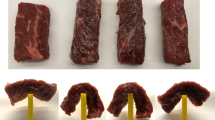Abstract
We studied the effect of 37-GHz electromagnetic field on proteolytic activity of pepsin in Wistar rats. The plane of polarization of the electromagnetic fields rotated in either right-handed or left-handed sense (D- and L-chirality). D-Polarization stimulated, while L-polarization suppressed pepsin production.
Similar content being viewed by others
REFERENCES
V. A. Avetisov and V. I. Gol'danskii, Usp. FIziol. Nauk, 166, No. 8, 873-891 (1996).
N. S. Andreeva, Mol. Biol., 28, No. 6, 1400-1406 (1994).
M. E. Arkhipov, T. I. Subbotina, and A. A. Yashin, Chiral Asymmetry of the Bioorganic Word: Theory and Experiment [in Russian], Tula (2002).
Yu. A. Lutsenko, S. I. Sokolovskii, S. A. Yashin, and A. A. Yashin, Electromagnetic Therapy in Stomatology [in Russian], Tula (2002).
Author information
Authors and Affiliations
Rights and permissions
About this article
Cite this article
Subbotina, T.I., Khadartsev, A.A., Yashin, M.A. et al. Effect of Rotating Electromagnetic Fields on Proteolytic Activity of Pepsin in Rats. Bulletin of Experimental Biology and Medicine 137, 632–634 (2004). https://doi.org/10.1023/B:BEBM.0000042731.04863.0b
Issue Date:
DOI: https://doi.org/10.1023/B:BEBM.0000042731.04863.0b



